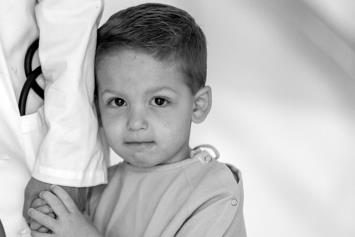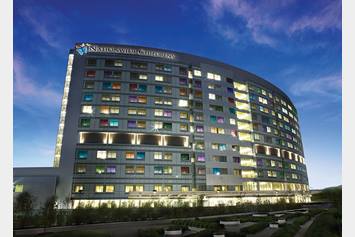Central Nervous System (CNS) Tumor
The central nervous system is responsible for controlling how your body functions. When tumors grow in the CNS, they can cause significant symptoms.
What Is a Central Nervous System Tumor?
The central nervous system (CNS) is made up of the brain and the spinal cord. This system is responsible for sending, receiving and processing information throughout your body, controlling how your body functions. When tumors grow in the central nervous system, they can cause significant symptoms.
Tumors can be benign (non-cancerous) or malignant (cancerous), but even benign tumors can cause issues if they grow and put pressure on other parts of the brain or spine. CNS tumors are the second most common childhood tumor type, with around 4,000 new cases diagnosed each year.
There are two sub-categories of these brain tumors, called primary and secondary tumors. Primary tumors start growing in the brain and can spread to other parts of the central nervous system, such as the spinal cord, but these tumors rarely spread to other areas of the body. Secondary brain tumors form when tumor cells spread from other areas of the body to the central nervous system. While seen in adults, these types of tumors are rare for children.
What Causes Central Nervous System Tumors in a Child?
Researchers have found that some genetic conditions that are passed down to offspring can give your child a higher risk of developing CNS tumors, but in most cases, there is no known cause. Researchers believe that something is absent in the brain or spinal cord cells during normal development. Specifically, cells of the brain and spinal cord grow and divide as the body develops. During this cell division process, cells need to replicate their genetic material. Errors can take place during this process, leading to mutations (changes in the gene structure), which may allow cells to grow into tumors. These errors generally occur randomly and cannot be prevented.
What Are the Signs and Symptoms?
Signs and symptoms will vary for each tumor due to the location, size and stage. The most common symptom found in patients with CNS tumors are headaches in the morning, accompanied by nausea and vomiting. Your child may also experience other symptoms such as:
- Problems with vision, speech or hearing
- Coordination problems, like difficulty walking or loss of balance
- Seizures
- Unexplained weight loss or gain
- Tilting their head to one side
- Weakness or tingling in one side of the body
- Changes in personality
- Problems with memory or concentrating
- Endocrine issues such as early puberty or increased thirst
- Back pain
- Scoliosis
- Infants may experience an increase head size
How Are CNS Tumors Diagnosed?
Your child's healthcare provider will ask about your child's health history and symptoms. The provider will do a physical exam and a neurological exam. The exam will test your child’s reflexes, muscle strength, eye and mouth movement and coordination. Your child's health care provider may refer your child to a cancer specialist (oncologist). Your child may need tests such as:
- CT Scan - A CT scan uses a series of X-rays and a computer to take pictures of the head or body. CT scans are very quick imaging, usually no more than a few minutes of scanning (though preparation may take longer).
- MRI - An MRI uses large magnets, radio waves and a computer to make detailed pictures of the body. Contrast dye may be injected into your child's vein to make tumors more visible. MRIs are very detailed imaging (provide much more information about the tumor), so take longer to perform (often 1-2 hours).
- Biopsy - Tumor cells are removed during surgery and sent to a lab for testing. This is done to find out the type of tumor (to finalize the tumor diagnosis) to determine how best to treat it and to understand how aggressive it is.
How Are CNS Tumors Treated?
Treatment for CNS tumors will be individualized based on the specific tumor diagnosis and severity as well as your child’s age. Your child’s treatment can include any or all of the following:
- Surgery - This is done to remove part or all the tumor. More surgery may be needed over time if the tumor grows back. Surgery may be followed by chemotherapy or radiation therapy.
- Chemotherapy - These are medicines that kill cancer cells. One or more medicines may be given. Medicines may be oral or given through an IV or central line.
- Targeted Therapy - These are medicines (usually oral) used to target specific genetic alterations in the cancer cells and kill them.
- Radiation Therapy - These are high-energy X-rays or other types of radiation. They are used to kill cancer cells or stop them from growing.
- Clinical Trials - A clinical trial is a way to test new treatments for cancer. Ask your child's healthcare provider if there are any treatments being tested that may work well for your child. Many new treatments are only available in clinical trials.
- Supportive Care - Medicines and other treatments can be used for pain, fever, infection, nausea and vomiting.
Other parts of treatment may include:
- Steroids - These are medicines that help prevent or reduce swelling in the brain or other parts of the body.
- Anticonvulsant Medicines - These help to prevent or control any seizures.
- Shunt Placement - A shunt is a small plastic tube. It’s put into the skull to drain any fluid that has built up in or around the brain. It is internal (all inside the body) and usually connects the ventricles (the parts of the brain containing spinal fluid) with the abdomen.
A child may have short- or long-term problems from the tumor or from treatment. They may include:
- Damage to the brain or nervous system that causes problems with coordination, muscle strength, speech or eyesight
- Problems after surgery, such as infection, bleeding and problems with general anesthesia
- Infection and an increased risk of bleeding from chemotherapy
- Delayed growth and development
- Learning problems
- Problems with reproduction (infertility)
- Return of the cancer (recurrence)
- Increased risk for other cancers later in life
Speak with your child’s doctor about what you should watch for and what can be done to help prevent complications.
Survivorship – Outcomes and Life After Central Nervous System Tumors
Improving the quality of life of survivors of brain and spine tumors is an area of much ongoing research and continued progress. Some patients have little to no long-term problems from their tumor or treatment, whereas other patients experience more significant side effects. All patients will continue to be followed by the oncology team after finishing treatment to ensure they are doing well and receive appropriate resources, therapies, and subspecialty team services as needed. Patients will also continue to get surveillance imaging (MRIs) to ensure their tumor does not grow back; as the time from end of treatment increases, these scans will be spaced further apart.
Why Choose Nationwide Children's?
The Neuro-Oncology Program at Nationwide Children’s Hospital offers clinical excellence in treating children, adolescents, and young adults with brain and spine tumors. Your child will have access to doctors who are experts in different types of medical care. We call this multidisciplinary care. Depending on the specific tumor diagnosis and treatment plan, your team may include oncologists, neurosurgeons, radiation oncologists, clinical psychologists, rehabilitation medicine doctors, neurologists, endocrinologists, ophthalmologists, therapists (physical, occupational, speech, art, music), social workers, dietitians and/or pharmacists. These team members all work together with the family to provide the best care for the patient.
Cancer Clinical Research
Nationwide Children’s is a national leader in oncology research and clinical trials. There are many ongoing research studies aimed at improving outcomes for children and young adults with brain/spine tumors—understanding why these tumors develop and how to appropriately target them. We are members of all major pediatric brain tumor clinical trial consortia including Pediatric Brain Tumor Consortium (PBTC), Collaborative Network of Neuro-oncology Clinical Trials (CONNECT), Pacific Neuro-oncology Consortium (PNOC) and the Children’s Oncology Group (COG). We have many open clinical trials testing new drugs in difficult-to-treat tumors, including in DIPG.
Next Steps
Speak With Our Team of Experts
Our team would be happy to answer any questions or schedule an appointment.
Request an Online Second Opinion
If you are currently receiving care at another institution and would like a second opinion from experts at Nationwide Children's, we can help.



